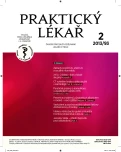Basics of social cognitive and affective neuroscience
XVIII. On happiness – humans and human groups
Authors:
F. Koukolík
Authors‘ workplace:
Primář: MUDr. František Koukolík, DrSc.
; Národní referenční laboratoř prionových chorob
; Thomayerova nemocnice, Praha
; Oddělení patologie a molekulární medicíny
Published in:
Prakt. Lék. 2013; 93(2): 39-43
Category:
Editorial
Overview
Happiness is state of mind or feeling characterized by contentment, love, satisfaction, pleasure or joy. There exist tools for direct measurement of happiness but they present challenges. So-called Easterlin paradox holds that economic growth does not add to the quality-of –life and that average happiness in nations has not risen in the last few decades, but other author had found a clear positive link between average levels of subjective well being and GDP per capita across countries. Human happiness probably involves more than current income (e.g. as argued by UN): happiness in almost 400 000 people living in OECD is positively correlated with absolute income, generosity of the welfare state and weakly with life expectancy. Material prosperity predicts life evaluation, whereas psychosocial prosperity predicts positive feeling: high income improves evaluation of life bud not emotional well-being. There is a evidence that individuals with transcriptionally more efficient version of the serotonin transporter gene are significantly more likely to report higher levels of life satisfaction and that there exists a dynamic spread of happiness in a large social network.
Keywords:
happiness – Easterlin´s paradox – serotonin transporter gene – social network
Sources
1. Caspi A, Sugden T, Moffitt T, et al. Influence of life stress on depression: moderation by polymorphism in the 5-HTT gene. Science 2003; 301 : 386–389.
2. Boyce CJ, Brown GDA, Moore SC. Money and Happiness: Rank of income, not income, affects life satisfaction. Psychol Sci 2010; 21(4): 471–475.
3. Brutland GH. Mental health in 21th century. Bull World Health Organ 2000; 78(4): 411 p.
4. Conceicao P, Bandura R. Measuring subjective wellbeing: a summary review of the literature [online]. Dostupné na: www.undp.org/developmentstudies/docs/subjective_wellbeing_conceicao_bandura.pdf
5. Deaton A. Income, health, and well-being around the world: evidence from the Gallup world poll. J Econ Perspect 2008; 22(2): 53–72.
6. Deaton A. Toll of transition in eastern Europe and former USSR. Gallup 2008, March 11 [online]. Dostupné na: www.gallup.com/poll/104881/toll-transition-eastern-europe-former-ussr.aspx
7. De Neve J-E, Fowler JH, Frey BS. 2011. Genes, economics, and happiness [online]. Dostupné na: jhfowler.ucsd.edu/genes_economics_and_happiness.pdf
8. Di Tella R, Mac Culloch R. Gross national happiness as an answer to the Easterlin paradox? J Dev Econ 2008; 86(1): 22-42. Dostupné též na: http://129.3.20.41/eps/mac/papers/0504/0504027.pdf
9. Easterlin RE. Does money buy happiness? Public Interest 1973; 30 : 3–10.
10. Easterlin RE. Does economic growth improve the human lot? Some empirical evidence. In David PA, Reder M. (eds.). National and households in economic growth: essay in honor of Moses Abramowitz. New York: Academic Press 1974.
11.Easterlin RE. Will raising the incomes of all increases the happiness of all? J Econ Behav Organ 1995; 27 : 35–48.
12. Easterlin RE. Feeding the illusion of growth and happiness: a reply to Hagerty and Veenhoven. Soc Indic Res 2005; 74 : 429–443.
13. Easterlin RA. Explaining happiness. Proc Natl Acad Sci USA 2003; 100 : 11176–11183.
14. Fowler JH, Christakis, NA. Dynamic spread of happiness in large social network: longitudinal analysis over 20 years in the Framingham Heart Study. BMJ 2008; 337: a2338. doi:10.1136/bmja2338.
15. Fox E, Ridgewell A, Ashwin Ch. Looking on the bright side: biased attention and the human serotonin transporter gene. Proc Royal Soc B 2009; 276 : 1747–1751.
16. Gallup World Poll Questions [online]. Dostupné na: http://media.gallup.com/dataviz/www/WP_Questions_WHITE.pdf
17. Gallup-Healthways Well Being Index [online]. Dostupné na: www.well-beingindex.com/
18. Hagerty MR, Veenhoven R. Wealth and happiness revisited – growing national income does go with greater happiness. Soc Indic Res 2003; 64 : 1–27.
19. Hills P, Argyle M. The Oxford Happiness Questionaire: a compact scale for the measurement of psychological well-being. Pers Individ Dif 2002; 33 : 1073–1082.
20. United Nations Development Programme (UNDP). Human Development Report 2009 – 2010 [online]. Dostupné na: http://hdr.undp.org/en/media/HDR_2010_EN_Complete_reprint.pdf
21. United Nations Development Programme (UNDP). Composite indices – HDI and beyond [online]. Dostupné na: http://hdr.undp.org/en/statistics/indices.
22. Kahneman D, Krueger AB, Schkade D, et al. Would you be happier if you were richer? A focusing illusion. Science 2006; 312 : 1908–1910.
23. Kahneman D, Dragon A. High income improves evaluation of life but not emotional well-being. Proc Natl Acad Sci 2010; 107 : 16849–16493.
24. Kashadan TB. The assessment of subjective well-being (issues raised by the Oxford Happiness Questionnaire). Pers Individ Dif 2004; 36 : 1225–1232.
25. Kesebir P, Diener E. In pursuit of happiness. Empirical answers to philosophical questions. Perspect Psychol Sci 2008; 3 : 117–125.
26. Sen A. The standard of living. Cambridge UK: Cambridge University Press 1991; 7–8.
27. Stevenson B, Wolfers J. Economic growth and subjective well-being: reassessing the Easterlin paradox. Brooking papers on economic activity. Institute for the Study of Labor, Bonn: Discussion Paper No. 3654, August 2008 [online]. Dostupné na: http://ftp.iza.org/dp3654.pdf
28. The World Bank. Adjusted net saving – a proxy for sustainability [online]. Dostupné na: http://go.worldbank.org/3AWKN2ZOY0
29. Veenhoven R, Hagerty M. Rising happiness in nations 2004. A reply to Easterlin. Soc Indic Res 2006; 79 : 421–436.
30. Veenhoven R. World Database of Happiness [online]. Dostupné na: http://worlddatabaseofhappiness.eur.nl/
31. World Values Survey Association. World Values Survey [online]. Dostupné na: http://www.worldvaluessurvey.org/
Labels
General practitioner for children and adolescents General practitioner for adultsArticle was published in
General Practitioner

2013 Issue 2
- Metamizole vs. Tramadol in Postoperative Analgesia
- Memantine in Dementia Therapy – Current Findings and Possible Future Applications
- Metamizole at a Glance and in Practice – Effective Non-Opioid Analgesic for All Ages
- What Effect Can Be Expected from Limosilactobacillus reuteri in Mucositis and Peri-Implantitis?
- Hope Awakens with Early Diagnosis of Parkinson's Disease Based on Skin Odor
Most read in this issue
- Cardiac computed tomography and its importance in cardiology K
- Paretic symptoms and complications in aseptic CNS infections
- Helicobacter pylori infection and immune thrombocytopenic purpura – a case report
- Vascular and psychosocial risk factor of Alzheimer's disease
